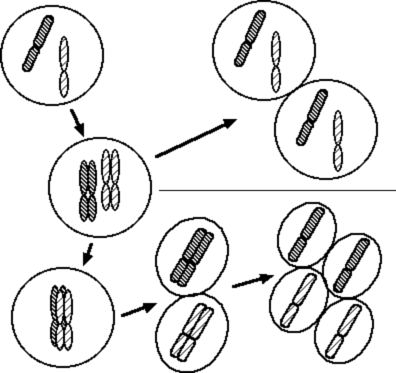Difference between Meiosis in males and females

Meiosis in males vs Meiosis in females
Reproduction is a very important process necessary for the continuation of the progeny. Sexual and asexual reproductions are the two different types of methods by which plants and animals reproduce. Asexual reproduction is the form of reproduction in which young ones are born from a single parent. In sexual reproduction, both the male and the female gametes unite to form offspring. Mitosis and meiosis are the two important steps of cell division that lead to formation of new life.
Meiosis is a special type of reproduction which is used by humans, animals and certain plants. Meiosis occurs in two different stages, meiosis 1 and meiosis 2. In human males, meiosis occurs in the seminiferous tubules of the testicles while in females, it occurs in cells called as oogonia. In males, meiosis occurs at puberty while in females it occurs right at birth. The retinoic acid formed by the primitive kidneys stimulates the process of meiosis in females at birth, but in males this formation of retinoic acid is suppressed till puberty by the tissues of the testis. This suppression is overcome when at puberty the sertoli cells start producing retinoic acid on their own. This is a very important difference in the steps of meiosis in males and females.
In meiosis 1, there is splitting of the gametes into two in such a way that there is reduction in the number of chromosomes to half of what is present originally in parent cell. Initially, there is crossing over of chromosomes derived from the parent cells which helps in mixing the characteristics from each parent, and then half of the total chromosomes get distinctly separated from the other. All the chromosomes get equally distributed in halves; hence, they also carry traits of their parent cells in equal proportion. This step is also called as ‘reductional division’ as during the process of division, chromosomes reduce to half the number than originally present. Next step is meiosis 2; in this stage there is internal splitting of one half of the daughter cells and what we get is four daughter cells with different permutation and combination of the chromosomes.
Meiosis is important in mammals because when the male and the female gametes fuse to form the zygote, then during the formation of the zygote there is replacement of the lost number of chromosomes to restore the number to the original 42 chromosomes. If during meiosis 1 or meiosis 2, there is an error during division, such that there is an extra chromosome or one chromosome less, then it is termed as non-disjunction. If there is non-disjunction, then it will lead to formation of zygotes with extra chromosomes and will lead to the birth of a child with many anomalies or even mental retardation. Therefore, meiosis is a very important step in reproduction. The daughter cells formed by female gametes carry only the X sex chromosome while the daughter cells formed by male gametes carry either an X or Y sex chromosomes. As a matter of fact, meiosis is important for formation of the zygote but once the zygote is formed it grows further to become a fetus by mitotic cell division. Mitosis is plain replication of the cells by keeping the chromosome number intact as the parent cells.
Summary: Meiosis occurs at birth in females in oogonia cells but occurs at puberty in males in the seminiferous tubules. Meiosis is a process of cell replication where there is reduction of the number of chromosomes to half from the original.
- Difference between near sightedness and far sightedness - January 21, 2015
- Difference between Diverticulosis and Diverticulitis - January 20, 2015
- Difference between Prilosec and Nexium - January 19, 2015
